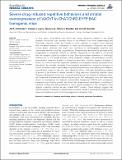Severe drug-induced repetitive behaviors and striatal overexpression of VAChT in ChAT-ChR2-EYFP BAC transgenic mice
Author(s)
Crittenden, Jill R.; Lacey, Carolyn J.; Lee, Tyrone; Bowden, Hilary Ann; Graybiel, Ann M.
DownloadCrittenden-2014-Severe drug-induced.pdf (2.463Mb)
PUBLISHER_POLICY
Publisher Policy
Article is made available in accordance with the publisher's policy and may be subject to US copyright law. Please refer to the publisher's site for terms of use.
Terms of use
Metadata
Show full item recordAbstract
In drug users, drug-related cues alone can induce dopamine release in the dorsal striatum. Instructive cues activate inputs to the striatum from both dopaminergic and cholinergic neurons, which are thought to work together to support motor learning and motivated behaviors. Imbalances in these neuromodulatory influences can impair normal action selection and might thus contribute to pathologically repetitive and compulsive behaviors such as drug addiction. Dopamine and acetylcholine can have either antagonistic or synergistic effects on behavior, depending on the state of the animal and the receptor signaling systems at play. Semi-synchronized activation of cholinergic interneurons in the dorsal striatum drives dopamine release via presynaptic nicotinic acetylcholine receptors located on dopamine terminals. Nicotinic receptor blockade is known to diminish abnormal repetitive behaviors (stereotypies) induced by psychomotor stimulants. By contrast, blockade of postsynaptic acetylcholine muscarinic receptors in the dorsomedial striatum exacerbates drug-induced stereotypy, exemplifying how different acetylcholine receptors can also have opposing effects. Although acetylcholine release is known to be altered in animal models of drug addiction, predicting whether these changes will augment or diminish drug-induced behaviors thus remains a challenge. Here, we measured amphetamine-induced stereotypy in BAC transgenic mice that have been shown to overexpress the vesicular acetylcholine transporter (VAChT) with consequent increased acetylcholine release. We found that drug-induced stereotypies, consisting of confined sniffing and licking behaviors, were greatly increased in the transgenic mice relative to sibling controls, as was striatal VAChT protein. These findings suggest that VAChT-mediated increases in acetylcholine could be critical in exacerbating drug-induced stereotypic behaviors and promoting exaggerated behavioral fixity.
Date issued
2014-05Department
Massachusetts Institute of Technology. Department of Brain and Cognitive Sciences; McGovern Institute for Brain Research at MITJournal
Frontiers in Neural Circuits
Publisher
Frontiers Research Foundation
Citation
Crittenden, Jill R., Carolyn J. Lacey, Tyrone Lee, Hilary A. Bowden, and Ann M. Graybiel. “Severe Drug-Induced Repetitive Behaviors and Striatal Overexpression of VAChT in ChAT-ChR2-EYFP BAC Transgenic Mice.” Front. Neural Circuits 8 (May 28, 2014).
Version: Final published version
ISSN
1662-5110